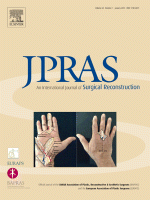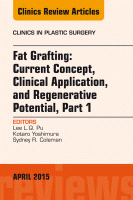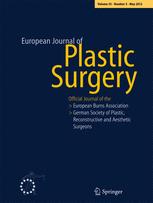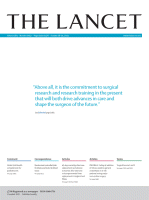 Pinna deformities, combined with congenital aural atresia, have been a matter of serious debate in the literature as they are associated with major aesthetic and functional problems that are difficult to manage. These problems have been described as early as 2000 BC. The aim of the present article is to approach the whole problem as one (pinna malformation and aural atresia) and present the history as well as the current approaches in reconstruction.
Pinna deformities, combined with congenital aural atresia, have been a matter of serious debate in the literature as they are associated with major aesthetic and functional problems that are difficult to manage. These problems have been described as early as 2000 BC. The aim of the present article is to approach the whole problem as one (pinna malformation and aural atresia) and present the history as well as the current approaches in reconstruction.
Publicado: . En: Historia, artes y personalidades. ![]()
 Rhinoplasty is considered one of the most commonly performed and most challenging operations in facial plastic surgery. The modern facial plastic surgeon utilizes many instruments in performing this procedure. Many of these instruments take their names from the pioneers who invented or designed them. Although meritorious, the recent trend in medicine to move away from eponyms in lieu of descriptive names should not come at the price of forgetting history. Although this communication does not seek to provide a comprehensive history of rhinoplasty or of its pioneers, our aim is to mention several of the salient contributing figures upon whose shoulders we stand and whose eponymous instruments we use commonly in rhinoplasty.
Rhinoplasty is considered one of the most commonly performed and most challenging operations in facial plastic surgery. The modern facial plastic surgeon utilizes many instruments in performing this procedure. Many of these instruments take their names from the pioneers who invented or designed them. Although meritorious, the recent trend in medicine to move away from eponyms in lieu of descriptive names should not come at the price of forgetting history. Although this communication does not seek to provide a comprehensive history of rhinoplasty or of its pioneers, our aim is to mention several of the salient contributing figures upon whose shoulders we stand and whose eponymous instruments we use commonly in rhinoplasty. Silver is a naturally occurring element. Similar to other metals, the ionized form of silver (Ag +1 ) has known antimicrobial properties. A number of wound dressings incorporating silver ion or silver compounds have recently been developed and marketed. In addition, the antimicrobial effects of silver are currently being promoted in consumer products such as clothing and household appliances. The present use of silver in medical and consumer products has prompted concerns for potential toxicity and ecological effects, including induction of microbial resistance to antibiotics. These concerns ignore the fact that silver has been used for medicinal purposes for several thousand years.
Silver is a naturally occurring element. Similar to other metals, the ionized form of silver (Ag +1 ) has known antimicrobial properties. A number of wound dressings incorporating silver ion or silver compounds have recently been developed and marketed. In addition, the antimicrobial effects of silver are currently being promoted in consumer products such as clothing and household appliances. The present use of silver in medical and consumer products has prompted concerns for potential toxicity and ecological effects, including induction of microbial resistance to antibiotics. These concerns ignore the fact that silver has been used for medicinal purposes for several thousand years. In his March 3, 2014 New Yorker cover cartoon “Ready for His Closeup”, Barry Blitt depicts Oscar ® , the statuette, as a plastic surgery patient. Labels from head to toe highlight the procedures that Oscar ® has had ranging from his scalp reduction to his pedestal augmentation. The only procedure that Oscar ® needed but did not have was a penile reconstruction.
In his March 3, 2014 New Yorker cover cartoon “Ready for His Closeup”, Barry Blitt depicts Oscar ® , the statuette, as a plastic surgery patient. Labels from head to toe highlight the procedures that Oscar ® has had ranging from his scalp reduction to his pedestal augmentation. The only procedure that Oscar ® needed but did not have was a penile reconstruction. Fat injection empirically started 100 year ago to correct contour deformities mainly on the face and breast. The German surgeon Eugene Hollaender (1867-1932) proposed a cocktail of human and ram fat, to avoid reabsorption. Nowadays, fat injection has evolved, and it ranks among the most popular procedures, for it provides the physician with a range of aesthetic and reconstructive clinical applications with regenerative effects on the surrounding tissues. New research from all over the world has demonstrated the role of adipose-derived stem cells, present in the adipose tissue, in the repair of damaged or missing tissues.
Fat injection empirically started 100 year ago to correct contour deformities mainly on the face and breast. The German surgeon Eugene Hollaender (1867-1932) proposed a cocktail of human and ram fat, to avoid reabsorption. Nowadays, fat injection has evolved, and it ranks among the most popular procedures, for it provides the physician with a range of aesthetic and reconstructive clinical applications with regenerative effects on the surrounding tissues. New research from all over the world has demonstrated the role of adipose-derived stem cells, present in the adipose tissue, in the repair of damaged or missing tissues. Abu Al-Qasim Khalaf ibn Abbas Al-Zahrawi (936–1013 CE, known to Europe as Albucasis) practised medicine and surgery in Córdova, the capital of Andalusia. He was a great mediaeval surgeon who influenced European surgery until the Renaissance. His magnum opus was an encyclopaedia of 30 treatises entitled Al-Tasreef. It encompassed the entire medical and surgical fields then known and it has been considered the first illustrated scientific text in history. Albucasis’ made significant contributions to plastic surgery. He stated that incisions be marked with ink preoperatively and advocated important principles of surgery: primary closure and debridement and closure and promoted the use of antiseptics in wounds.
Abu Al-Qasim Khalaf ibn Abbas Al-Zahrawi (936–1013 CE, known to Europe as Albucasis) practised medicine and surgery in Córdova, the capital of Andalusia. He was a great mediaeval surgeon who influenced European surgery until the Renaissance. His magnum opus was an encyclopaedia of 30 treatises entitled Al-Tasreef. It encompassed the entire medical and surgical fields then known and it has been considered the first illustrated scientific text in history. Albucasis’ made significant contributions to plastic surgery. He stated that incisions be marked with ink preoperatively and advocated important principles of surgery: primary closure and debridement and closure and promoted the use of antiseptics in wounds. In 1945, with the fighting in Europe over, a curious story appeared in the pages of British newspapers. It concerned the war record of James Hutchison, an army colonel standing for Parliament in that July’s general election. A year earlier, so Hutchison had revealed to the press, he had parachuted into Nazi-occupied France to work with the French Resistance. What had really caught journalists’ attention, however, was his claim to have disguised his wartime identity by undergoing surgery to his face.
In 1945, with the fighting in Europe over, a curious story appeared in the pages of British newspapers. It concerned the war record of James Hutchison, an army colonel standing for Parliament in that July’s general election. A year earlier, so Hutchison had revealed to the press, he had parachuted into Nazi-occupied France to work with the French Resistance. What had really caught journalists’ attention, however, was his claim to have disguised his wartime identity by undergoing surgery to his face.





 Sitio web publicado el
Sitio web publicado el
Los lectores comentan